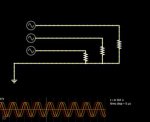That Man
Member
- Location
- California, United States
- Occupation
- Electrical Designer
I can't quite tell if I'm having a senior moment, or if I've stumbled on something I haven't considered before, though I suspect it's the first one. I'm calculating voltage drops on a 3 phase 4 wire system where all the loads are single phase LN.
At the the end of the circuit there is a 3A load on phase A to N, so A current is 3A, N current is 3A.
Second to last load is 3A phase B to N, so B current is 3A, N Current is...
My guess is a phase shift of 60 degrees with an amplitude of 1.73x 3 = 5.2A.
First load is 3A phase A to N, so A current is 3A, N current is...
My guess is zero, as this N would cancel out the 2 other N's, so current at the N terminal from the source panel is zero.
Does this sound correct?
At the the end of the circuit there is a 3A load on phase A to N, so A current is 3A, N current is 3A.
Second to last load is 3A phase B to N, so B current is 3A, N Current is...
My guess is a phase shift of 60 degrees with an amplitude of 1.73x 3 = 5.2A.
First load is 3A phase A to N, so A current is 3A, N current is...
My guess is zero, as this N would cancel out the 2 other N's, so current at the N terminal from the source panel is zero.
Does this sound correct?







